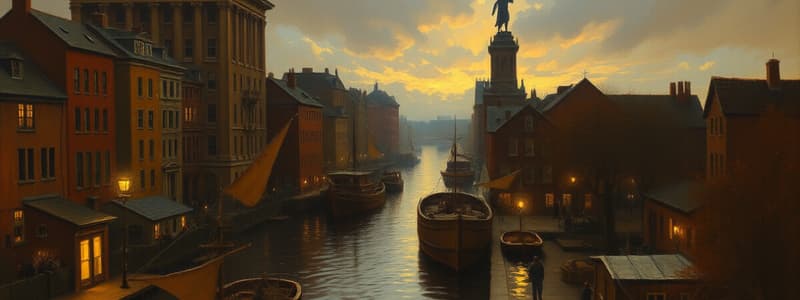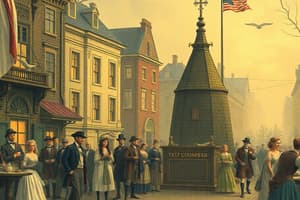Podcast
Questions and Answers
On March 2, 1770, ropemaker Samuel ______ got into a brawl with several soldiers.
On March 2, 1770, ropemaker Samuel ______ got into a brawl with several soldiers.
Gray
Private Hugh White, a sentry at the Customs house and member of the ______ Regiment chimed in defending Goldfinch.
Private Hugh White, a sentry at the Customs house and member of the ______ Regiment chimed in defending Goldfinch.
29th
Goldfinch continued on his way and ignored Gerrish’s ______.
Goldfinch continued on his way and ignored Gerrish’s ______.
shouts
A club was thrown from the crowd, hitting Private Hugh ______, knocking him down.
A club was thrown from the crowd, hitting Private Hugh ______, knocking him down.
Three people died on the scene: Crispus Attucks, Samuel Gray, and James ______.
Three people died on the scene: Crispus Attucks, Samuel Gray, and James ______.
Samuel Maverick died a few hours later, and Patrick Carr succumbed to his injuries two weeks later, bringing the traditional total of deaths to ______.
Samuel Maverick died a few hours later, and Patrick Carr succumbed to his injuries two weeks later, bringing the traditional total of deaths to ______.
Hutchinson dispersed the crowd from the State House ______ stating, 'The law shall have its course...'.
Hutchinson dispersed the crowd from the State House ______ stating, 'The law shall have its course...'.
An enormous funeral service was held for the ______.
An enormous funeral service was held for the ______.
This intermittent brawl went on for _____ days and nights between Boston’s gangs and the soldiers.
This intermittent brawl went on for _____ days and nights between Boston’s gangs and the soldiers.
Wigmaker’s apprentice, Edward Gerrish accused Captain John Goldfinch of not _____ for his services.
Wigmaker’s apprentice, Edward Gerrish accused Captain John Goldfinch of not _____ for his services.
Private Hugh White struck Gerrish on the side of the head with the _____ of his musket.
Private Hugh White struck Gerrish on the side of the head with the _____ of his musket.
Hearing the noise, a _____ began to form.
Hearing the noise, a _____ began to form.
With the knowledge that the mob could turn violent at any moment, Preston ordered the guard to turn out, go to _____ Street.
With the knowledge that the mob could turn violent at any moment, Preston ordered the guard to turn out, go to _____ Street.
Montgomery’s musket _____ and the other soldiers subsequently fired into the crowd.
Montgomery’s musket _____ and the other soldiers subsequently fired into the crowd.
After the muskets went off, Preston sent the men back to the _____ house.
After the muskets went off, Preston sent the men back to the _____ house.
By 2 am, the sheriff detained Captain _____ after the incident.
By 2 am, the sheriff detained Captain _____ after the incident.
Christopher Seider was reburied along with the _____ of the incident.
Christopher Seider was reburied along with the _____ of the incident.
Preston ordered the guard to load their _____ in response to the crowd.
Preston ordered the guard to load their _____ in response to the crowd.
Study Notes
The Boston Massacre Events
- Samuel Gray, a ropemaker, instigated a brawl with soldiers seeking work at John Gray's Ropewalk on March 2, 1770.
- The conflict escalated over three days between Boston gangs and soldiers, highlighting tensions in the community.
- Edward Gerrish, a wigmaker's apprentice, accused Captain John Goldfinch of not paying for his hairdressing services.
- Private Hugh White defended Goldfinch and struck Gerrish with his musket, leading to further provocation from Gerrish and other apprentices.
- A crowd formed, escalating the confrontation, and Captain Thomas Preston ordered soldiers to load their muskets due to the mob's potential violence.
The Aftermath of Violence
- A club thrown from the crowd knocked down Private Hugh Montgomery, causing his musket to discharge.
- In response, soldiers fired into the crowd, resulting in 11 injuries and 5 deaths, including Crispus Attucks, Samuel Gray, and James Caldwell.
- Samuel Maverick died hours later, and Patrick Carr succumbed to injuries two weeks later.
- Governor Hutchinson called for law and order from the State House window, asserting, “The law shall have its course”.
Legal Consequences
- By 2 a.m., the sheriff detained Captain Preston after the violence.
- An enormous funeral service was held for the victims, with Christopher Seider reburied alongside them.
- John Adams, who would become a key figure in the American Revolution, defended Preston and the soldiers in court.
- Six soldiers were acquitted while two were found guilty of manslaughter.
Impact on Revolutionary Sentiment
- The Sons of Liberty quickly utilized the Boston Massacre to fuel the Patriot cause.
- Paul Revere is credited with an iconic engraving of the incident, though it was based on an earlier work by Henry Pelham.
- Both artworks depicted the violent scene on King Street, enhancing resentment toward British troops and contributing to the path toward the American Revolution.
The Boston Massacre Events
- Samuel Gray, a ropemaker, instigated a brawl with soldiers seeking work at John Gray's Ropewalk on March 2, 1770.
- The conflict escalated over three days between Boston gangs and soldiers, highlighting tensions in the community.
- Edward Gerrish, a wigmaker's apprentice, accused Captain John Goldfinch of not paying for his hairdressing services.
- Private Hugh White defended Goldfinch and struck Gerrish with his musket, leading to further provocation from Gerrish and other apprentices.
- A crowd formed, escalating the confrontation, and Captain Thomas Preston ordered soldiers to load their muskets due to the mob's potential violence.
The Aftermath of Violence
- A club thrown from the crowd knocked down Private Hugh Montgomery, causing his musket to discharge.
- In response, soldiers fired into the crowd, resulting in 11 injuries and 5 deaths, including Crispus Attucks, Samuel Gray, and James Caldwell.
- Samuel Maverick died hours later, and Patrick Carr succumbed to injuries two weeks later.
- Governor Hutchinson called for law and order from the State House window, asserting, “The law shall have its course”.
Legal Consequences
- By 2 a.m., the sheriff detained Captain Preston after the violence.
- An enormous funeral service was held for the victims, with Christopher Seider reburied alongside them.
- John Adams, who would become a key figure in the American Revolution, defended Preston and the soldiers in court.
- Six soldiers were acquitted while two were found guilty of manslaughter.
Impact on Revolutionary Sentiment
- The Sons of Liberty quickly utilized the Boston Massacre to fuel the Patriot cause.
- Paul Revere is credited with an iconic engraving of the incident, though it was based on an earlier work by Henry Pelham.
- Both artworks depicted the violent scene on King Street, enhancing resentment toward British troops and contributing to the path toward the American Revolution.
Studying That Suits You
Use AI to generate personalized quizzes and flashcards to suit your learning preferences.
Description
Test your knowledge on the tumultuous events that took place in Boston in March 1770, including the famous brawl involving Samuel Gray and British soldiers. Explore the social dynamics and conflicts of the era that shaped early American history. This quiz will challenge your understanding of this pivotal moment.



